Sikkim : Food & Drinks (Contd...)
Gundruk & Sinki
Gundruk and Sinki are traditional fermented vegetable products prepared during winter when fresh perishable vegetable is plenty. Gundruk is a fermented product of leafy vegetable such as rayo sag (Brasicca rapa spp. campestris variety cuneifolia), leaves of mustard, radish and cauliflower. Sinki is prepared from radish tap root only. The quality attributes to Gundruk and Sinki basically depends upon the typical flavour and sour-acidic taste which is developed during natural fermentation by lactic acid bacteria, mainly spp. of Lactobacillus and Pediococcus. Gundruk and Sinki are sun dried after fermentation and stored for consumption. Due to high content of organic acid and low pH, these products can be preserved for a year or more. This is a good example of biopreservation of perishable vegetable. Gundruk and Sinki are good appetizers due to high content of lactic and acetic acid developed during fermentation.
Gundruk and Sinki soup
(fermented vegetable)
Serves 6 to 8
Gundruk/Sinki 50 g
Onion 1 chopped
Tomato 1 chopped
Dry red chili 2 pods
Turmeric powder 1/2 Tablespoon
Salt 1 Teaspoon
Preparation : Soak Gundruk/Sinki in water for 10 min. Heat oil and fry chopped onions, tomatoes, chilies. Drain up soaked Gundruk/Sinki and fry, add turmeric powder and salt, and put 2 cups of water. Boil for 10 min, and serve hot with cooked rice.
Gundruk ko achar
(pickle)
Serves 6
Gundruk 50 g
Onion 1 chopped
Green chilies 3 chopped
Oil 1 Tablespoon
Salt 1 Teaspoon
Preparation : Mix all ingredients, and serve as achar (pickle) along with cooked rice.
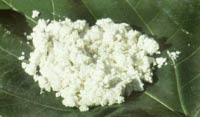 Chhurpi
Chhurpi
Chhurpi is a fermented dairy product prepared from cow milk. Chhurpi is a traditional cottage cheese which gives a texture of a white soft mass with mild sour taste. It is fermented by spp. of lactic acid bacteria. Average consumption of Chhurpi is 9.9.g/capita/day with annual production of 1469 ton in Sikkim.
Chhurpi soup
(traditional cottage cheese)
Serves 6
Chhurpi 250 g
Onion 1 chopped
Tomato 1 sliced
Green chilies 3 sliced
Ginger 1 Tablespoon (grated)
Paanch phoran 1/2 Tablespoon
Turmeric powder 1/4 Tablespoon
Salt 1 Teaspoon
Preparation : Heat oil, fry Paanch phoran, add chopped onion till it becomes golden brown. Add finely sliced and grated ginger, tomatoes and seasoned with Chhurpi and add salt. Stir and fry till oil separates. Garnish with fresh coriander leaves. Serve hot with cooked rice.
Chhurpi ko achar
(pickle)
Serves 6
Chhurpi 250 g
Onion 1 chopped
Radish/Cucumber 1 sliced
Green chilies 6 chopped
Mustard oil 1 Teaspoon
Salt 1 Teaspoon
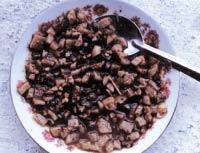 Mesu
Mesu
Mesu is a traditional fermented bamboo shoot product with sour-acidic taste eaten as pickle. In the Limbu dialect, me means young bamboo shoot and su means sour, the word Mesu is directly derived from the Limbu dialect. Young bamboo shoots are fermented under natural anaerobic condition for 7-15 days, initiated by spp. of Lactobacillus and Pediococcus to get Mesu. It has high content of organic acid and low pH with rich mineral contents.
Mesu pickle
(fermented bamboo shoot)
Serves 4 to 6
Mesu 250 g
Chili powder 3 Teaspoon
Mustard oil 1 Tablespoon
Garlic 4 piece, crushed
Salt 1 Teaspoon
Preparation : Mix all ingredients with mesu. Keep in a closed jar. Mesu is ready to serve with cooked rice.
Tama
Tama is a non-fermented bamboo shoot product. Some varieties of bamboo shoots commonly grown in the Sikkim Himalayas are Dendrocalamus hamiltonii, Dendrocalamus sikkimensis and Bambusa tulda locally known as ‘choya bans’, ‘bhalu bans’ and ‘karati bans’, respectively are edible when young. These bamboo shoots are collected, defoliated and boiled in water with turmeric powder for 10-15 min to remove bitter taste of bamboo. Tama is ready for consumption. Tama is commonly sold in the local markets during the months of June to September when young bamboo shoots sprout.
Tama curry
(Non-fermented bamboo shoot)
Serves 4
Tama 250 g
Methi (Asafetida) 1/2 Teaspoon
Turmeric powder 1/2 Tablespoon
Salt 1/2 Teaspoon
Dale khorsani (Fresh round chili) 1 sliced
Preparation : Heat oil and fry dry asafetida seeds. Put finely sliced Tama, turmeric powder, sliced round chili and salt. Stir and cook for 3 minutes. Tama, curry is ready to serve with cooked rice.
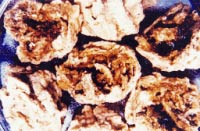 Masauyra
Masauyra
Masauyra is a fermented black gram, ball-like hollow product consume as spicy condiment. Masauyra is mostly common among Newar of the Nepalis. It is similar to the Punjabi Wari.
Masauyra curry
(fermented black gram)
Serves 4
Masauyra 50 g
Onion 1 chopped
Cumin seeds 1 Teaspoon
Turmeric powder 1 Teaspoon
Salt 1 Teaspoon
Preparation : Heat oil, add cumin seeds, sautéed chopped onions, Masauyra turmeric powder and salt, and fry for 2 min. Pour 1 cup of hot water and cook for 10 min. Masauyra curry is ready to serve with cooked rice.
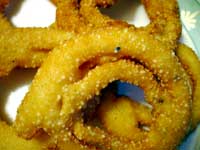 Saelroti
Saelroti
Widely prepared during Nepali festivals, Saelroti is normally eaten with potato curry or non-vegetarian dish. Normally not available in restaurants but Saelroti is prepared from well-mixed fermented rice batter which is deep fried, ring-shaped, spongy, pretzel-like product commonly consume as confectionery bread in festival and special occasions. The batter is fermented by spp. of yeasts and lactic acid bacteria.
Selroti
(fermented rice product)
Serves 8 to 10
Rice 1000 g
Wheat flour 250 g
Milk 500 ml
Sugar 200 g
Ghee 100 g
Preparation :Wash and soak rice overnight; pound into fine powder. The rice flour supplemented with butter, sugar and some spices are made into batter by adding milk and 2 cups of water, and allowed to ferment for between 4 h during summer and 24 h during winter at room temperature. The leavened batter is squeezed by hand and deposited as continuos ring onto hot edible oil till they become gold brown. Selroti is served as staple confectionery bread with Shimi ko achar and mutton curry.
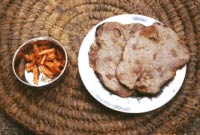 Kodo ko Roti
Kodo ko Roti
Kodo ko roti is typical pancake prepared from finger millet locally called Kodo which is served with different varieties if pickles.
Kodo ko roti
(non-fermented finger millet pancake)
Serves 6 to 8
Finger millet flour 3 cups
Sugar 1 Tablespoon
Ghee 2 Tablespoon
Preparation : Mix finger millet flour-sugar with 1 cup of lukewarm water and knead to make a thick paste. Heat ghee in a frying pan and spread tablespoon heaped of paste into a greased frying pan. Thoroughly cook over medium heat, and remove. Repeat with remaining mixture. Kodo ko roti is served with pickles.